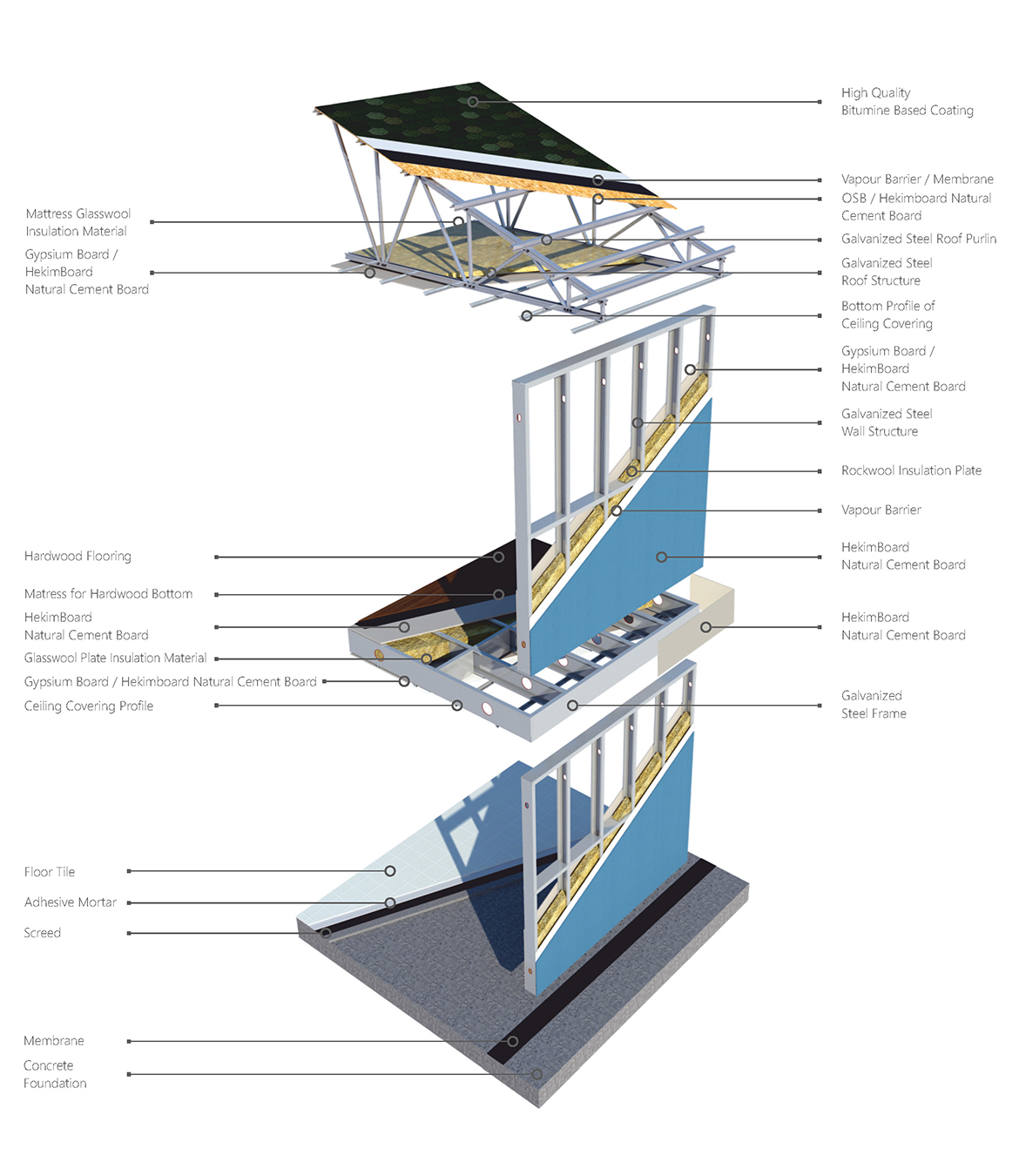Light Steel Construction System
Hekim Light Gauged Steel Construction System
Cross Section of Light Gauged Steel Construction System

Technical Specifications

Construction

Wall
Optional
- Patterned HekimBoard Natural Cement Board
- Fuga patterned HekimBoard Natural Cement Board
- Turksiding patterned Natural Cement Board
- Sheathing application
- Facade coating application
- Windows and doors jambs (HekimBoard Natural Cement Board/XPS)

Roof
Optional
- Natural galvanized corrugated steel sheet
- Painted galvanized corrugated steel sheet
- Hekim Sandwich Roof Panel
- Corrugated bituminous board covering
- Patterned membrane
- Metal roof tile
- PVC / metal rain gutter and drain pipe

Insulation
Glasswool mattress is used for insulation of roof.
Optional
- Rockwool

Doors
Interior doors are MDF-Laminated doors.
Optional
- Aluminium
- Door with photocell
- PVC
- Sectional door
- Fireproof door
- Aluminium
- American door (Steel sheet or wooden frame)
- PVC
- Double-acting door
- Fireproof door

Windows
Optional
- Colored and wood patterned PVC frame
- Colored and wood patterned aluminium frame
- Sliding or guillotine frame
- Tilt & turn frame
- Thermal insulated aluminium frame
- Aluminium or PVC roller shutters
- Insect screen

Paint
Hekim plastic paint is used for interior surface.
Optional
- Satin paint
- Mineral plaster for sheathing
- Patine paint

Electricity Installation
The installation is surface mounted.
Optional
- Data line
- Telephone line
- UPS
- TV
- Fire detection system
- Alarm and smart building systems

Sanitary Installation
Installation is
surface mounted.
Optional
- Hilton washbasin
- Jacuzzi
- Bathtub
- Shower cabinet
- Fire extinguishing system
- Heating and ventilation system
What Is a Light Steel Construction System?
A light steel construction system refers to a building framework made primarily from cold-formed, galvanized steel sections. This approach, also known as light gauge steel construction, is typically used in low to mid-rise buildings, modular structures, and even high-end custom homes. The components are manufactured under controlled conditions, ensuring high precision and minimal waste.
This system stands out because it combines lightweight materials with high structural integrity. Unlike traditional timber framing, light steel construction is resistant to warping, pests, and fire, making it a safer and more reliable option. As sustainability becomes a major focus in the construction industry, light gauge steel modular construction offers significant advantages in terms of recyclability, reduced site disruption, and energy efficiency. It provides a modern, streamlined alternative to conventional construction practices.
How Is a Light Steel Construction System Structured?
A typical light steel construction system is built using a series of pre-engineered steel profiles that are bolted or screwed together to form the skeleton of a building. These profiles include studs, tracks, joists, and trusses, which are precisely cut and shaped in a factory before being transported to the construction site.
The structural system is often based on a panelized design where wall and floor panels are assembled either on-site or in modular format. These panels form the structural envelope, to which insulation, cladding, and internal finishes are added. Because of its modular nature, light gauge steel frame construction allows for fast and efficient assembly, often reducing construction time by 30–50% compared to traditional methods. This method also supports flexible architectural designs, enabling the creation of complex building geometries with ease.
Technical Specifications of Light Steel Construction Systems
Technical specifications for light steel construction systems vary depending on the building’s size, location, and intended use. Typically, the steel used ranges from 1.0 mm to 2.5 mm in thickness, made from galvanized or coated steel coils to prevent corrosion. Structural calculations are essential to determine the exact size and spacing of studs and joists, ensuring load-bearing capacity and compliance with building codes.
Another critical aspect is thermal and acoustic performance. Light steel construction systems often incorporate high-efficiency insulation materials within wall cavities and floor systems to meet energy codes and enhance indoor comfort. Moreover, considerations for fire resistance, seismic activity, and wind loads must be factored into the design phase. The system’s success hinges on accurate detailing and adherence to light steel frame construction details, which govern every joint, connection, and fastening point.
Benefits of Using Light Steel Construction Systems
There are numerous benefits associated with adopting a light steel construction system. One of the most significant advantages is speed. Since most components are prefabricated, on-site construction time is drastically reduced. This is particularly useful in urban developments or disaster relief housing where time is of the essence.
Durability is another key advantage. Light gauge steel construction is immune to rot, termites, and other biological threats. It also offers excellent dimensional stability, meaning buildings retain their shape and structural integrity over time. Cost-effectiveness is often cited, especially in projects involving repetitive or modular designs, where economies of scale can be realized. Additionally, these systems have a lower environmental impact due to less material waste, recyclable content, and reduced transportation needs.
How Are Light Steel Construction Systems Manufactured?
Manufacturing a light steel construction system involves precision engineering and automation. The process begins with structural design, where software tools like CAD or BIM are used to create detailed models. Once the design is finalized, the specifications are sent to roll-forming machines that cut and shape the steel coils into various profiles.
Each piece is labeled and bundled for easy identification during assembly. The manufacturing process ensures high accuracy, reducing human error and the need for on-site modifications. These systems are often pre-punched for electrical and plumbing services, which further speeds up the installation process. Quality control is paramount during manufacturing to guarantee that each element meets engineering and safety standards. Because of this, light gauge steel frame construction is known for its consistency and reliability in diverse climates and conditions.
How Are Light Steel Construction Systems Installed?
Installation of a light steel construction system is a streamlined process. Once components are delivered to the site, they are laid out according to the architectural plans. Wall panels are lifted into place, secured to the foundation, and then connected with horizontal and vertical supports. Floor systems and roof trusses follow a similar sequence.
Since the profiles are lightweight, they can be handled without heavy machinery, reducing labor costs and site disruption. Skilled workers use screws, bolts, and other fasteners to connect parts securely. Integration with other building systems—like HVAC, electrical, and plumbing—is often simpler than with traditional construction due to pre-designed service routes. Overall, installation can be completed rapidly, sometimes allowing for full enclosure of a structure within days.
Applications of Light Steel Construction Systems
Light steel construction systems are versatile and suitable for a wide range of building types. In the residential sector, they are often used for single-family homes, townhouses, and multi-family units. Their precision and speed make them ideal for affordable housing and infill developments.
In commercial applications, they’re commonly found in hotels, office buildings, and schools. Because light gauge steel modular construction supports off-site manufacturing, it’s particularly advantageous in projects with tight deadlines or logistical constraints. These systems are also increasingly used in industrial and temporary structures, such as warehouses, military bases, and emergency shelters. Their adaptability and scalability mean they can meet diverse architectural and engineering demands with minimal adjustment.
Choosing the Right Light Steel Construction System for Your Project
Selecting the appropriate light steel construction system depends on several factors, including the building’s function, size, location, and budget. A detailed needs analysis should be conducted early in the planning phase. This involves evaluating structural loads, energy performance requirements, acoustic needs, and local building codes.
Working with experienced designers and suppliers is essential to ensure the system you choose meets all technical and regulatory standards. For custom projects or complex builds, modular solutions might offer better flexibility. On the other hand, standardized systems can be more economical for large-scale developments. Whether you’re pursuing light steel frame construction details for a small home or planning a large modular facility, aligning your system choice with your project goals is key to long-term success.
